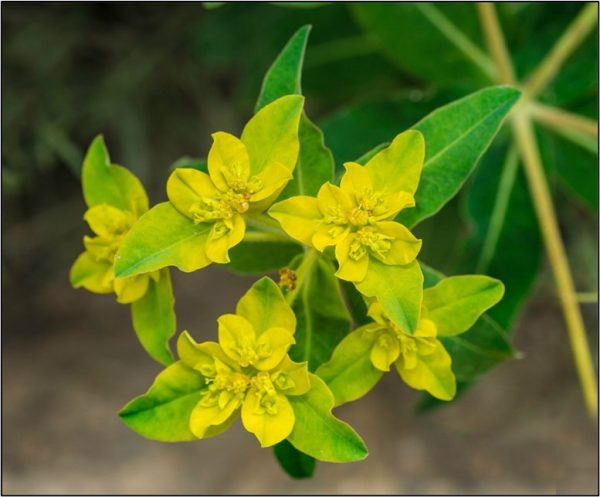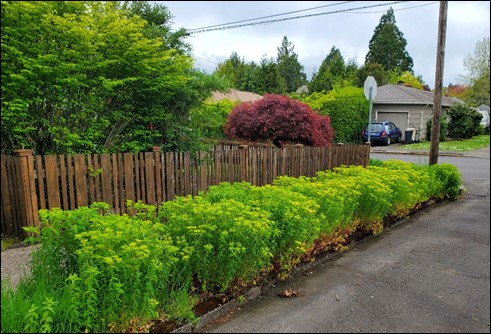The Dirt | Purge the Spurge!
This year, Benton Soil and Water Conservation District obtained another year of grant funding for their “Purge the Spurge!” project. This undertaking began as a response to four sightings of oblong spurge (Euphorbia oblongata) in Benton County in 2019. Oblong spurge is a high priority A-List noxious weed as designated by the Oregon Department of Agriculture. This designation means current infestation levels of oblong spurge in Benton County are at a low enough scale for feasible containment. More than 25 sites in the Corvallis, Philomath, and Lewisburg areas are currently being monitored. These sites are treated with herbicide or mechanical removal. The immediate goals of 2023’s “Purge the Spurge!” project is to continue the control of known sites, identify and treat new sites, and increase public education. This year we added an additional focus on rural sites in the Vineyard Mountain area. Because Vineyard Mountain is comprised of oak woodland and natural areas, the containment of oblong spurge at these sites is a high priority. By using the Early Detection Rapid Response method, it is expected that oblong spurge can be eradicated from Benton County.

Originally valued as an ornamental plant, many landowners intentionally planted oblong spurge in their yards. Now, oblong spurge is a potential menace for Benton County’s natural areas. This sun-loving noxious weed is typically found in upland habitats or garden spaces, with a preference for well-drained to dry soils. The biology of oblong spurge allows it to quickly move into oak woodlands and infest the understory, driving out existing plant species. The sap is also toxic, making it unpalatable for wildlife and livestock and a skin irritant for humans. A changing climate may potentially favor oblong spurge over native species, as it has done noticeably well in hot, dry locations. Once oblong spurge is established in an area, it is very difficult to remove.
The results of public outreach around this species have been very successful, leading to the discovery of numerous new oblong spurge sites. Correct timing of site treatments is especially important for success, making outreach efforts similarly targeted. Community engagement often falls during the months of May and June as oblong spurge begins to bloom and before it goes to seed. The small, yellow flowers make it easy to spot because of their unique appearance. The involvement of gardening enthusiasts, recreationalists, and residents is a valuable source of reporting. As part of this year’s project, “Purge the Spurge!” presented a “Know Your Weeds” workshop spotlighting oblong spurge. This community presentation offered insights in weed management and exhibited live samples of weeds for identification. A recording of the presentation will be available through the Benton SWCD website.
“Purge the Spurge!” has also hired their first Seasonal Conservation Technician. It is exciting to support a new career in ecology, and the new technician is assisting in site treatments and outreach efforts. Extensive neighborhood correspondences, organization partnerships, listserv communications, and park signage have all provided valuable outreach opportunities. As the season develops, plans for training OSU students as surveyors, making connections with walking groups, and social media posts will also be put into effect.

With the recent weather, oblong spurge has already begun blooming. As you make your morning commute or work in your garden, please be on the lookout for oblong spurge. Note that it looks VERY similar to several other Euphorbia species that are common in plant nurseries. Benton SWCD recommends that if you think you see oblong spurge, to contact us immediately:
- Email michael@bentonswcd.org with the date and location that oblong spurge was spotted, being as specific as possible.
- In your email, include images that show the whole population, an up-close of the individual plant, and any defining characteristics you notice. Michael Ahr, the project manager, will verify that you have the right plant. This way you can be sure to pull the correct weed instead of a harmless ornamental plant.
- If you were correct in your identification, Benton SWCD can provide free removal and treatment. Alternative landscaping plants may also be provided as part of this project if oblong spurge removal disrupts your yard space.
If you decide to remove this weed yourself, it is essential that the entire plant is thrown away using a trash bag. Do not put it in the compost, as this can still spread the seeds. Furthermore, only touch oblong spurge while wearing gloves as the milky sap may cause irritation.
Again, please do not hesitate to contact michael@bentonswcd.org with any questions you may have. Let’s work together to eradicate oblong spurge from Benton County!
This project is made possible thanks to funding received from the Oregon State Weed Board and assistance from the Oregon Department of Agriculture Invasive Weed Program. A big thank you also goes to the local community and partners for participating in this project.

